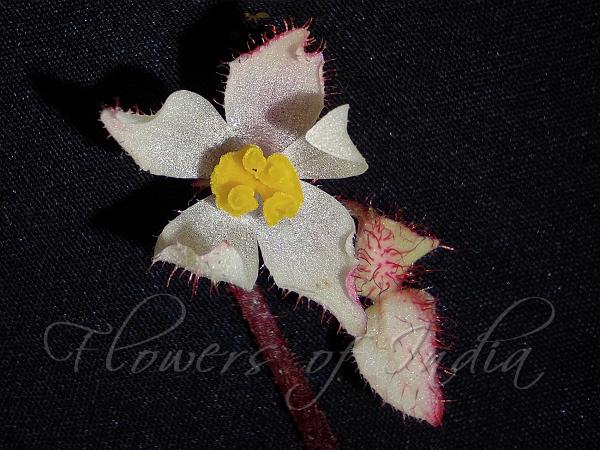|
| Tripura Begonia |
|

|

| File size | 678639 |
| Original date | 1/30/23 5:14 PM |
| Resolution | 2592 x 1944 |
| Flash | Flash did not fire |
| Focal length | 0.0mm |
| Exposure time | 1.0s |
| Aperture | 0.0 |
| Focus Distance | |
| Metering Mode | Center weighted average |
| Camera make | -- |
| Camera model | -- |
| Sensor type | MonochromeArea |
|
|
|
|
Photo: |
Botanical name: Begonia tripurensis Family: Begoniaceae (Begonia family)
Tripura Begonia is newly discovered (2024) begonia
species from Tripura. It is similar to
Begonia thomsonii but differs in
the size of the plant, hairiness, leaf-stalk length, flowers, stamens
and fruits. It is a perennial, creeping herb, 20-30 cm high.
Erect stems are only seen during flowering, reddish, minutely hairy.
Leaves are 6 or 7; leaf-stalk 10-12 x 0.5-0.7 cm, densely hairy;
blade 7-10 x 4-8 cm, ovate to broadly ovate, base heart-shaped,
basal lobes overlapping when young. Flowers are borne in cymes in leaf-axils,
few, somewhat-drooping, hairy, primary flower-cluster-stalk 5-10 cm long,
secondary 1-3 cm long. Male flowers are 5-7, flower-stalk 1.5-2 cm long,
velvet-hairy, tepals 4, white to pink, outer tepals broadly ovate to
round, 1-1.2 x 1-1.1 cm, pinkish hairy on the outer surface, tip
pointed, inner 2 tepals elliptic to ovate, 5-8 x 2-3 mm, hairless,
tip blunt; stamens 40-60, about 2 mm long, almost equal, anthers obovate,
tip notched, basifixed, lower anthers sub-stalkless, central anthers on a
filament up to 2 mm long. Female flowers are 2 or 3, flower-stalk 1-1.2
cm long; tepals 5, pinkish-white, 4 outermost sub-equal, hairy on the
outer surface, ovate, 9-10 x 4-5 mm, inner one smaller, hairless,
elliptic to ovate, 6-7 x 3-4 mm, tip rounded; ovary 5-7 x 8-10 mm
excluding wings, reddish, sparsely hairy locules 2; styles 2,
5-7 mm long, fused at the base, spiraled; wings 3, upper wing oblong,
6-8 x 3-5 mm, tip tapering, lateral wings 2, underdeveloped. Capsule is
somewhat-drooping, 1.5-1.7 x 1.2-1.4 cm, upper wing larger 15-20 x 5-6
mm, lateral wings 2, 2-3 x 5-6 mm. As of now Tripura Begonia is
known only from Tripura. Flowering: January-March.
| Identification credit: Dipankar Borah, Dixit Bora | Photographed near Dumboor Lake, Tripura. |
• Is this flower misidentified? If yes,